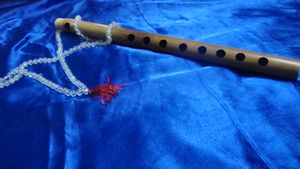فلوت
الفلوت هي آلة نفخية مصنوعة من المعدن وغالبا تكون من الفضة وأحيانا من الذهب أو البلاتين ونادرا من الخشب طولها 66 سم ومجالها الصوتي ثلاثة أوكتافات. يصدر الصوت في الفلوت عن ارتطام الهواء الداخل إلى أنبوب الفلوت بالجدار الداخلي لأنبوب الفلوت ، طول هذا العمود الهوائي يحدد العلامة الموسيقية لذلك فإنه عند فتح وإغلاق الفتحات الموجودة على سطح الأنبوب يتم تغيير طول العمود الهوائي وبالتالي تغيير العلامة الموسيقية ويعود استخدامها إلى أواسط القرن التاسع عشر حيث استخدمت في أوروبا ضمن الآلات الموسيقية للفرق العسكرية وحالياً تستخدم ضمن فرق الآلات النفخية أو فرق الأوركسترا.
التاريخ

The oldest flute ever discovered may be a fragment of the femur of a juvenile cave bear, with two to four holes, found at Divje Babe in Slovenia and dated to about 43,000 years ago. However, this has been disputed.[1][2] In 2008 another flute dated back to at least 35,000 years ago was discovered in Hohle Fels cave near Ulm, Germany.[3] The five-holed flute has a V-shaped mouthpiece and is made from a vulture wing bone. The researchers involved in the discovery officially published their findings in the journal Nature, in August 2009.[4] The discovery was also the oldest confirmed find of any musical instrument in history,[5] until a redating of flutes found in Geißenklösterle cave revealed them to be even older with an age of 42.000 to 43.000 years.[6]


الأصناف
آلات الكونشرتو الغربي=
الفلوت الهندي
الفلوت الصيني
الفلوت الياباني
The Japanese flute, called the fue, 笛 ([[[hiragana]]: ふえ] Error: {{nihongo}}: transliteration text not Latin script (pos 15: ふ) (help)), encompasses a large number of musical flutes from Japan, both of the end-blown and transverse varieties.
Sodina and suling
انظر أيضاً
- Diple
- Frula
- فلوت أيرلندي
- Jazz flute
- Kaval
- Native American flute
- Palendag
- Pipe and tabor
- Tin whistle
- Washint
الهامش
- ^ Tenenbaum, David (2000). "Neanderthal jam". The Why Files. University of Wisconsin, Board of Regents. Retrieved 14 March 2006.
{{cite web}}: Unknown parameter|month=ignored (help) - ^ Flute History, UCLA. Retrieved June 2007.
- ^ Ghosh, Pallab. (2009-06-25) BBC: 'Oldest musical instrument' found. BBC News. Retrieved on 2013-08-10.
- ^ Nicholas J. Conard, Maria Malina, and Susanne C. Münzel (2009). "New Flutes Document the Earliest Musical Tradition in Southwestern Germany". Nature. 460 (7256): 737–40. Bibcode:2009Natur.460..737C. doi:10.1038/nature08169. ISSN 0028-0836. PMID 19553935.
{{cite journal}}: Unknown parameter|month=ignored (help)CS1 maint: multiple names: authors list (link) - ^ "'Oldest musical instrument' found". BBC news. 2009-06-25. Retrieved 2009-06-26.
- ^ خطأ استشهاد: وسم
<ref>غير صحيح؛ لا نص تم توفيره للمراجع المسماةjhevol
وصلات خارجية
- Essay on the Jiahu flutes from the Heilbrunn Timeline of Art History at The Metropolitan Museum of Art
- A selection of historic flutes from around the world at The Metropolitan Museum of Art
- nature.com New flutes document the earliest musical tradition in southwestern Germany
- فلوت at the Open Directory Project
- Flute acoustics Resources on flute acoustics from the University of New South Wales.


